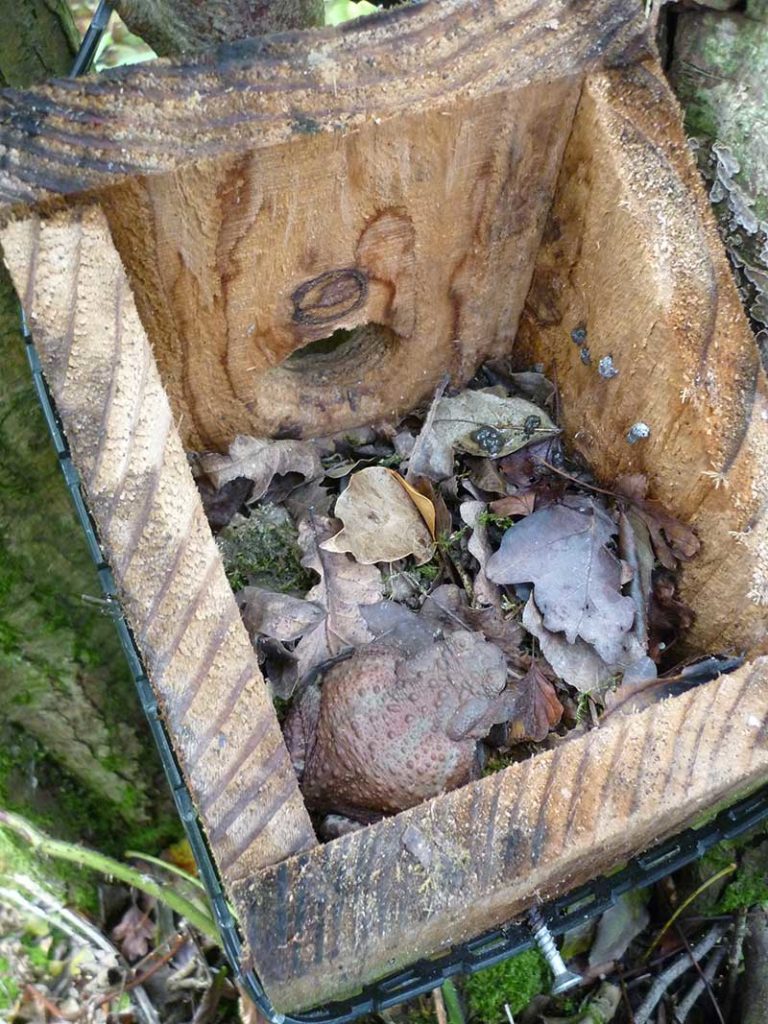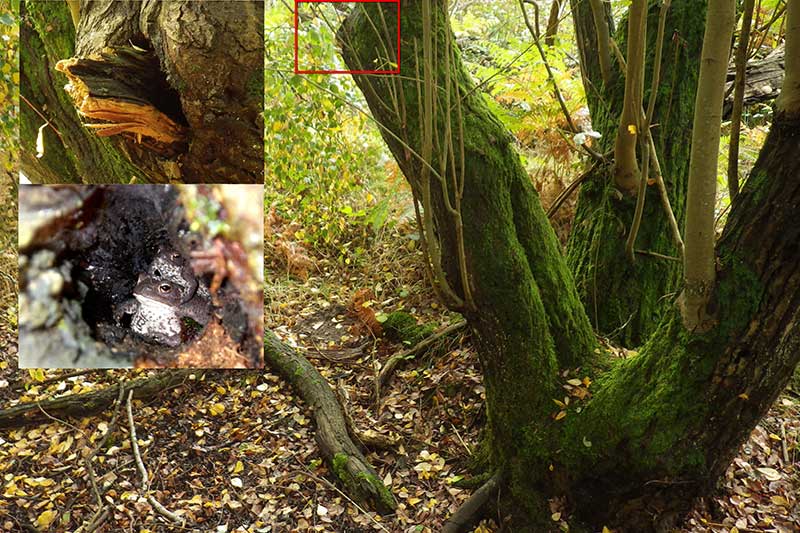New research has discovered the extent to which common toads live in trees. It’s the first time that the tree climbing potential of amphibians has been investigated at a national scale.
A surprising discovery
Researchers from the University of Cambridge and Froglife, supported by People’s Trust for Endangered Species (PTES), made the surprising discovery when common toads were found in nest boxes and tree cavities by volunteers who were looking for hazel dormice and bats as part of the National Dormouse Monitoring Programme (NDMP) and the Bat Tree Habitat Key project (BTHK).
Common toads (Bufo bufo) are widely distributed across Europe and the UK, occupying a variety of habitats, from woodland to wetlands, farmland and even urbanised areas. When they’re mature, toads breed in large ponds or lakes and can travel extensive distances between their terrestrial and aquatic habitats. Their spring migrations make them vulnerable to being killed on the roads. Sadly, toads are typically the most common vertebrate species killed on roads across Europe.
To date, there have only been a handful of documented sightings of common toads in trees. Consequently, common toads, and in general, UK amphibians, have never been surveyed for in trees, unlike bat and dormouse surveys, which specifically target such habitat.
Common toads could be found in up to 1 in every 100 trees
Over 50 records of common toads were found in surveys of hazel dormice nest boxes (located 1.5m above ground) and tree cavities usually used by bats. The highest record of a toad was found 3m up a tree. The surveys don’t regularly involve looking in tree hollows much higher but there’s a chance that toads might be venturing even further up.

Many of the cavities were small or not visible from the ground, so it’s unclear how toads are finding them and how difficult it is for them to climb particular trees.
Toads weren’t found in boxes or tree holes with other species, however they were found using old nests made by dormice and even birds. Whilst 50 records isn’t a huge number, it was comparable to records of other animals we know use trees regularly such as blue tits, suggesting that perhaps toads are much more arboreal than we previously thought. If this is true, it means that common toads could be found in up to 1 in every 100 or so trees in the UK in particularly favourable areas, such as near large ponds or lakes.
Image credit Matt Bramwich
Tree cavities more ecologically important than initially thought
The exciting discovery of arboreal behaviour in common toads means that tree cavities might represent an even more important ecological feature than conservationists thought. It highlights the importance of protecting our remaining natural woodland habitats, especially ancient trees with veteran features (such as hollows, cracks and other natural cavities) for all wildlife. Froglife research in 2016 showed that common toads have declined by 68% on average over the last 30 years across the UK.

It isn’t currently known why toads are climbing trees and using nest boxes. Factors could include searching for food, avoiding predators or evading parasites (such as toad fly). Critically, this study highlights the importance of sharing data between conservation organisations representing different species, and shows there’s a lot to learn about wildlife in the UK – even those we think of as well-known.
First author Dr Silviu Petrovan, Trustee at Froglife and Senior Researcher at the University of Cambridge says: “These findings are significant and very exciting for our understanding of the ecology and conservation of common toads, one of the most widespread and abundant European amphibians. We know common toads favour woodlands as foraging and wintering habitat, but it appears their association with trees is much more complex that we thought.”
“It also highlights the importance of collaborations and sharing data between conservation groups. Further, targeted research will enable scientists to better understand the reasons for this behaviour and the impact on woodland management for common toads and other amphibians.”
Found a toad up a tree? Record it!
If you’re interested in helping toads further, you can download Froglife’s Dragon Finder App to record other amphibians sightings, and volunteer to take part in Froglife’s Toads on Roads project, moving toads safely across roads. Don’t forget to keep recording and photographing any other species you find in dormouse nest boxes as part of your regular surveys.
See the research paper in full:
Header image credit Erni, Shutterstock
